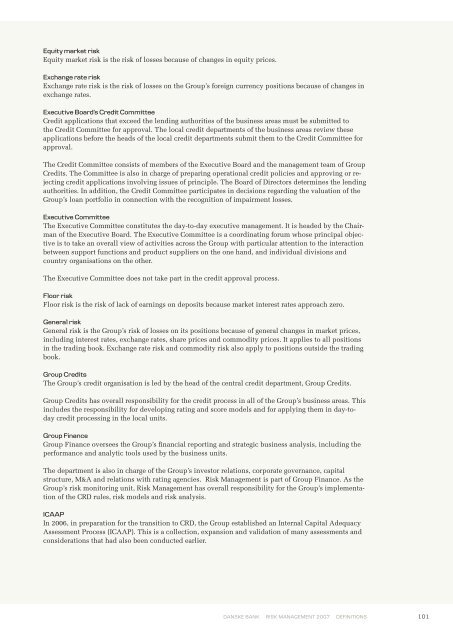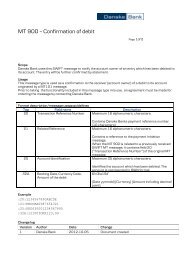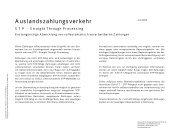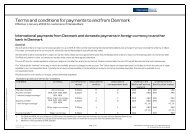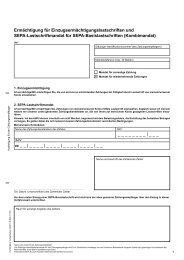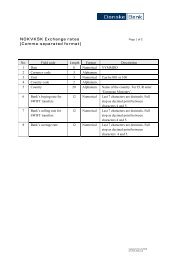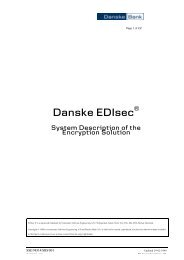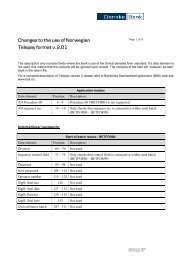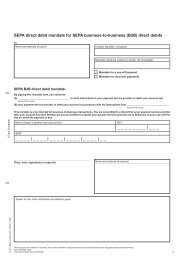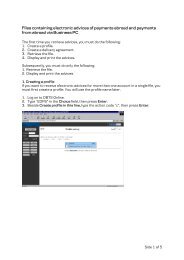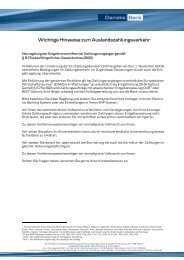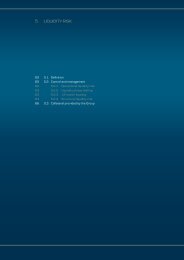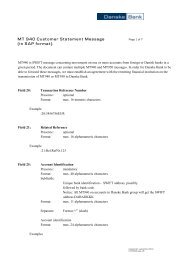10. dEFiNiTiONS - Danske Bank
10. dEFiNiTiONS - Danske Bank
10. dEFiNiTiONS - Danske Bank
You also want an ePaper? Increase the reach of your titles
YUMPU automatically turns print PDFs into web optimized ePapers that Google loves.
Equity market risk<br />
Equity market risk is the risk of losses because of changes in equity prices.<br />
Exchange rate risk<br />
Exchange rate risk is the risk of losses on the Group’s foreign currency positions because of changes in<br />
exchange rates.<br />
Executive Board’s Credit Committee<br />
Credit applications that exceed the lending authorities of the business areas must be submitted to<br />
the Credit Committee for approval. The local credit departments of the business areas review these<br />
applications before the heads of the local credit departments submit them to the Credit Committee for<br />
approval.<br />
The Credit Committee consists of members of the Executive Board and the management team of Group<br />
Credits. The Committee is also in charge of preparing operational credit policies and approving or rejecting<br />
credit applications involving issues of principle. The Board of Directors determines the lending<br />
authorities. In addition, the Credit Committee participates in decisions regarding the valuation of the<br />
Group’s loan portfolio in connection with the recognition of impairment losses.<br />
Executive Committee<br />
The Executive Committee constitutes the day-to-day executive management. It is headed by the Chairman<br />
of the Executive Board. The Executive Committee is a coordinating forum whose principal objective<br />
is to take an overall view of activities across the Group with particular attention to the interaction<br />
between support functions and product suppliers on the one hand, and individual divisions and<br />
country organisations on the other.<br />
The Executive Committee does not take part in the credit approval process.<br />
Floor risk<br />
Floor risk is the risk of lack of earnings on deposits because market interest rates approach zero.<br />
General risk<br />
General risk is the Group’s risk of losses on its positions because of general changes in market prices,<br />
including interest rates, exchange rates, share prices and commodity prices. It applies to all positions<br />
in the trading book. Exchange rate risk and commodity risk also apply to positions outside the trading<br />
book.<br />
Group Credits<br />
The Group’s credit organisation is led by the head of the central credit department, Group Credits.<br />
Group Credits has overall responsibility for the credit process in all of the Group’s business areas. This<br />
includes the responsibility for developing rating and score models and for applying them in day-today<br />
credit processing in the local units.<br />
Group Finance<br />
Group Finance oversees the Group’s financial reporting and strategic business analysis, including the<br />
performance and analytic tools used by the business units.<br />
The department is also in charge of the Group’s investor relations, corporate governance, capital<br />
structure, M&A and relations with rating agencies. Risk Management is part of Group Finance. As the<br />
Group’s risk monitoring unit, Risk Management has overall responsibility for the Group’s implementation<br />
of the CRD rules, risk models and risk analysis.<br />
ICAAP<br />
In 2006, in preparation for the transition to CRD, the Group established an Internal Capital Adequacy<br />
Assessment Process (ICAAP). This is a collection, expansion and validation of many assessments and<br />
considerations that had also been conducted earlier.<br />
DANSKE BANK RISK MANAGEMENT 2007 DEFINITIONS<br />
101


